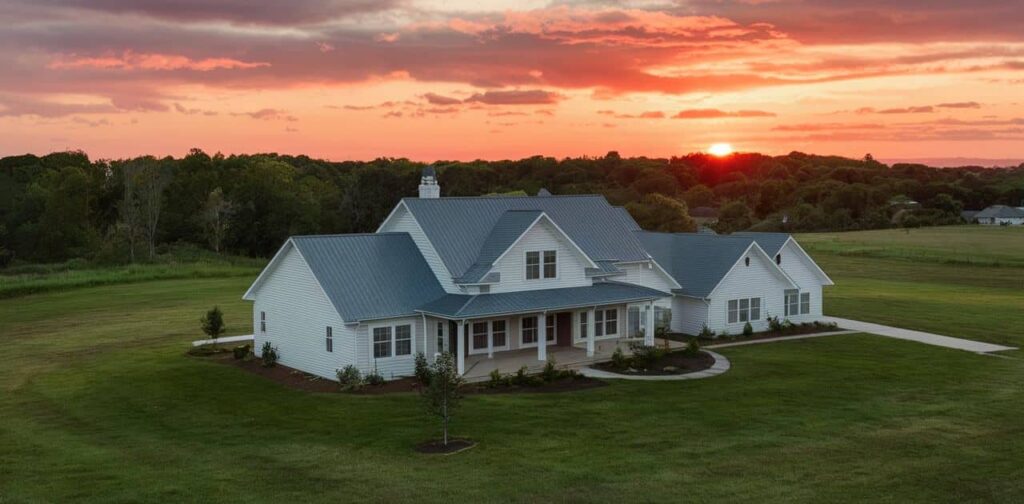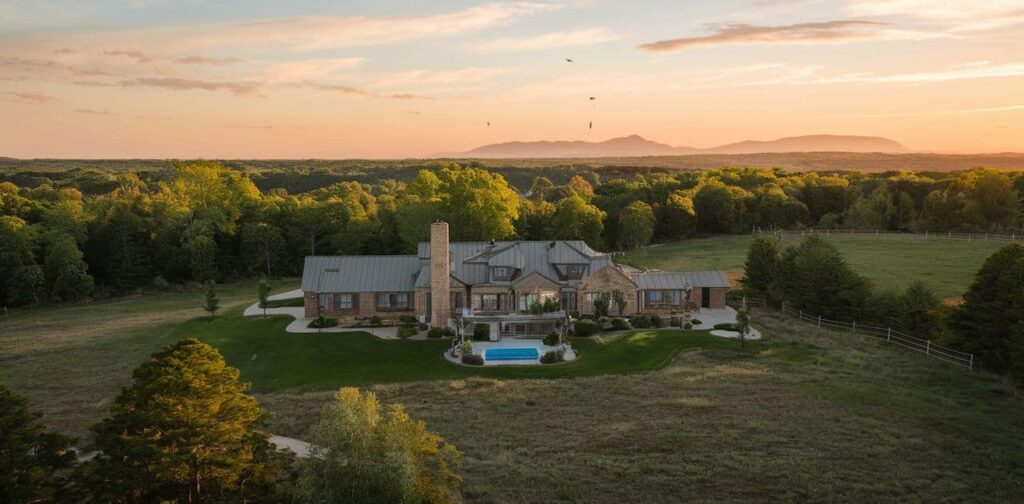Ever dreamed of building your own home from scratch? It’s exciting, but can feel overwhelming too. That’s where this guide comes in handy.
Navigating building on your own land means planning and overseeing the entire process of constructing a house on property you own. It involves finding the perfect plot, securing financing, hiring builders, and making countless decisions along the way.
Why go through all this trouble? Simple: you get to create exactly what you want, where you want it. No compromises.
The Land Hunt: Finding Your Perfect Spot
Remember when you were a kid and thought finding buried treasure would be the coolest thing ever? Well, finding the right piece of land to build your dream home on is pretty close to that feeling. But instead of X marking the spot, you’ll need to do a bit more legwork.
Scout It Out: First things first, you need to find that perfect piece of real estate. You’ve got a few options here:
- Team up with a seasoned real estate agent who knows the area like the back of their hand.
- Chat with home builders – they often have the inside scoop on great lots.
- Go solo and explore on your own. Just be prepared for a bit of an adventure!
Seal the Deal: The Land Purchase Process Once you’ve found your slice of heaven, it’s time to make it yours. But hold up – before you start picturing yourself sipping lemonade on your future porch, there’s some paperwork to tackle.
Financing Your Dream: Show Me the Money!
Unless you’ve got a mattress stuffed with cash (and if you do, maybe we should talk about better investment strategies), you’ll need to figure out how to finance this endeavor. Here are your options:
- Construction Loan: This is like a short-term loan to get your house built. It’s usually for about a year and has a higher interest rate. Think of it as the scaffolding that supports your dream until it’s ready to stand on its own.
- Land Loan: If you’re buying raw land (think more “Wilderness Explorer” than “Suburbia”), you might need a special land loan. These can be trickier to get, so put on your negotiating hat.
- Construction-to-Permanent Loan: This is the Swiss Army knife of loans. It covers the construction and then morphs into your long-term mortgage. One set of paperwork, one closing cost. Efficiency at its finest!
- Cash Purchase: If you’ve got the funds, buying outright can simplify things. Just make sure you’re not emptying your piggy bank completely.
- Seller Financing: Sometimes, the person selling the land might be willing to act as the bank. It’s like buying a car from your uncle – just make sure everything’s in writing!
Also, read this interesting blog:
Dallas Vs. Austin: Choosing The Right City In Texas
Choosing Your Home’s Architect: The Custom Home Builder

Now comes the fun part – choosing who’s going to bring your vision to life. Picking a custom home builder is like choosing a dance partner; you need someone who can follow your lead but also knows when to take charge.
- Look for experience and a portfolio that makes you go “Wow!”
- Check references – don’t be shy about asking for them.
- Make sure they’re licensed and insured. You want a pro, not your cousin’s friend who “knows a thing or two about houses.”
Designing Your Dream: Floor Plans and Home Design
This is where your napkin sketches come in handy. It’s time to turn those dreams into blueprints.
- Hire an architect if you want something truly unique.
- Browse your builder’s existing plans – they might have something that’s close to perfect.
- Or, if you’re feeling brave, try your hand at designing it yourself. Just maybe run it by a professional before you start building, okay?
Breaking Ground: Let the Construction Begin!
Finally, it’s time to turn that empty lot into a construction site. This is where things get real – and dusty.
- Expect some noise and a lot of activity.
- Be prepared for the unexpected. Mother Nature loves to throw curveballs.
- Stay involved, but trust your builder. They’re the experts, after all.
Moving Day Prep: Out With the Old, In With the New
While your dream home is taking shape, start getting ready for the big move.
- If needed, find a temporary place to live. Building a house isn’t an overnight process.
- Start packing early. Trust me, you have more stuff than you think.
- If you’re selling your current home, get it market-ready. A little curb appeal goes a long way!
The Final Step: Switching to a Mortgage
Construction’s done, and your home is ready. Time to switch gears financially.
- If you went with a construction-to-permanent loan, you’re already set.
- Otherwise, it’s time to shop for a long-term mortgage. Fixed-rate, 15 or 30 years – choose what works best for your financial future.
The Million Dollar Question: How Much Will This Cost?

Ah, the question everyone wants to know but is afraid to ask. Building a house on your land isn’t just about the structure – there’s a lot more to consider.
Factors That’ll Impact Your Wallet:
- Size Matters: How many square feet are you dreaming of?
- Location, Location, Location: Are utilities already available, or are you pioneering new territory?
- Land Prep: Is your lot ready to go, or does it need some TLC?
- The House Itself: From basic to luxury, your choices will impact the price tag.
- Extras: Want a pool? A mega garage? Factor these in.
Hidden Costs to Keep in Mind:
- Utility Hookups: Getting power, water, and internet to your new home can cost a pretty penny.
- Permits and Fees: The government wants its share too.
- Landscaping: Unless you’re going for the “just moved in” look.
- Driveways: Sometimes overlooked, but definitely necessary.
The Real Deal: Lexington, SC Edition
If you’re eyeing the Lexington, SC area for your new home, you’re in luck. It’s a great place to put down roots. But remember, every area has its quirks when it comes to building. Here’s what you need to know:
- Local regulations might impact your building plans.
- The cost of materials and labor can vary, so get local quotes.
- Consider the area’s growth – it might affect your property value down the line.
Making It Happen: Your Action Plan
Ready to turn this dream into reality? Here’s your step-by-step guide:
- Get your finances in order. Know what you can afford before you fall in love with a piece of land.
- Start your land search. Drive around, talk to locals, work with a realtor.
- Once you find the perfect spot, do your due diligence. Check zoning, utilities, and any restrictions.
- Secure your financing. Whether it’s a loan or cash, get your money lined up.
- Choose your builder. Interview several and trust your gut.
- Design your home. This is where the fun really begins!
- Navigate the permit process. Your builder can usually help with this.
- Watch your home come to life. Regular site visits keep you in the loop.
- Prepare for move-in day. It’ll be here before you know it!
- Enjoy your new, custom-built home. You’ve earned it!
Is Building on Your Own Land Right for You?

Building a home on your own land is an adventure. It’s not always easy, but for many, it’s incredibly rewarding. You get to create exactly what you want, where you want it. No compromises, no settling for “almost perfect.”
But it’s not for everyone. It requires patience, flexibility, and sometimes, a good sense of humor. You’ll need to make countless decisions and maybe deal with a few setbacks along the way.
If you’re ready for the challenge and excited about the prospect of creating your perfect home from the ground up, then building on your own land might be your perfect next step.
Remember, every great home starts with a dream and a plan. So dream big, plan carefully, and get ready to build the home you’ve always wanted. Who knows? This time next year, you could be reading this from the comfort of your brand-new, custom-built home. Now that’s something to look forward to!
Summary
Building your dream home on your own land is an exciting journey. This guide walks you through the process, from finding the perfect plot to moving in. We cover financing options, choosing builders, and navigating potential challenges. Remember, it’s about creating a home that’s uniquely yours. While it requires patience and decision-making, the reward is a custom home that fits your lifestyle perfectly. Whether you’re ready to start or just exploring the idea, this article provides the roadmap you need to turn your dream into reality.
FAQ’s
What to do first if you want to build a house?
First, assess your finances and set a realistic budget. Then, start searching for suitable land. Research local zoning laws and building regulations. Once you’ve found potential plots, get them evaluated for buildability. Simultaneously, start thinking about your home design and researching reputable builders in the area.
Can I build a house on my land in the UK?
Yes, you can build a house on your land in the UK, but you’ll need planning permission from your local authority. The process involves submitting detailed plans, adhering to building regulations, and potentially navigating restrictions if the land is in a conservation area or has other special designations.
What are the first 5 steps to building a house?
- Secure financing and set a budget
- Find and purchase suitable land
- Hire an architect or choose a house plan
- Select a builder and get necessary permits
- Begin site preparation and foundation work
What do I wish I knew before building a house?
Many people wish they knew:
- The importance of a detailed, itemized contract
- How often unexpected costs arise
- The time commitment required for decision-making
- The value of researching and visiting other new builds
- The need for flexibility as plans often change during construction
I want to build a house on my land where do I start?
Start by confirming that your land is suitable for building. Check zoning laws, access to utilities, and any building restrictions. Then, set your budget and secure financing. Next, start designing your home or choose a pre-existing plan. Finally, research and select a reputable builder to bring your vision to life.
Is it cheaper to build a house on your own land?
It can be cheaper in the long run, as you’re not paying for someone else’s profit on the land. However, initial costs might be higher, especially if the land needs significant preparation or utility connections. The overall cost depends on factors like location, land condition, home size, and materials used.
Cost to build a house if you already own the land?
The cost varies widely based on location, size, and quality of materials. On average, building a house can cost anywhere from $100 to $200 per square foot, not including land. For a 2,000 square foot home, you might expect to pay $200,000 to $400,000 for construction. Remember to factor in additional costs like utility connections, landscaping, and any required land preparation.
Read more related home improvement blogs
Homeowner’s Insurance In High Risk Areas
Should I Buy A House With A West Facing Garden?
Does A Smart TV Need An Aerial?

Howdy is behind this home blog, sharing personal stories, thoughts, and insights from daily life. I can dedicated to bringing you the latest trends, expert advice, and creative ideas to make your home the sanctuary you’ve always dreamed of. Whether you’re looking for DIY tips, home decor inspiration, home loans, rentals or renovations.







